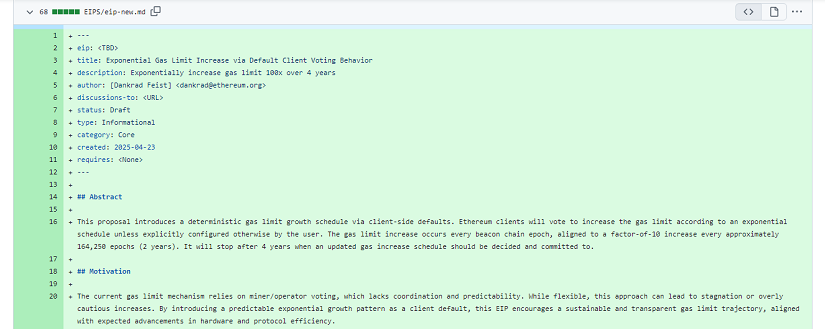TL;DR
- Ethereum researcher Dankrad Feist proposed EIP-9698, aiming to increase the gas limit by 100 times over four years.
- The initiative would allow Ethereum’s Layer 1 to process up to 2,000 transactions per second, massively boosting performance.
- The plan aligns with expected hardware and protocol improvements and could rebalance the current Layer 2-centric scaling approach.
Ethereum could be on the brink of a major scalability breakthrough thanks to a bold proposal by leading researcher Dankrad Feist. The EIP-9698 suggests an exponential increase in the gas limit, skyrocketing from today’s 36 million to an impressive 3.6 billion over a four-year period. The increase would follow a gradual and predictable path, with tenfold expansions every two years, starting in June 2025. This strategy could allow Ethereum’s base layer to reach speeds of up to 2,000 transactions per second, breaking through the bottlenecks that have historically limited the network’s performance.

A Strategic Plan To Unleash Ethereum’s Full Potential
Feist argues that this exponential growth would provide a sustainable boost to the network, adapting naturally to anticipated hardware and protocol improvements. Furthermore, since the increases would be gradual, node operators would have ample time to adjust and optimize their systems. This initiative arrives alongside another proposal, EIP-7935, which plans to raise the gas limit to 150 million during the upcoming Fusaka hard fork later this year. Feist and his team’s vision is clear: empower Layer 1 scalability without sacrificing the decentralization that has been Ethereum’s cornerstone since its 2015 launch.
History shows that Ethereum has consistently evolved its capacity: from just 5,000 gas units per block at launch, to stabilizing around 30 million following “The Merge” in 2022. Despite these milestones, its current throughput of 15–30 transactions per second has left it lagging behind faster competitors like Solana, which boasts tens of thousands of TPS.
A Golden Opportunity To Strengthen Ethereum’s Competitive Edge
Currently, Ethereum’s gas fees have remained low (around 1–2 gwei) thanks to innovations like proto-danksharding and the massive migration of activity to Layer 2 solutions. However, critics argue that relying heavily on these layers introduces risks of fragmentation and centralization, given that many Layer 2s depend on centralized sequencers.

By significantly strengthening Layer 1’s capacity, Ethereum could not only reclaim ground against high-speed blockchains but also solidify its role as the premier decentralized infrastructure. This proposal represents a logical and necessary evolution for an ecosystem that, while robust, still holds massive untapped potential to lead the next wave of mass adoption.










